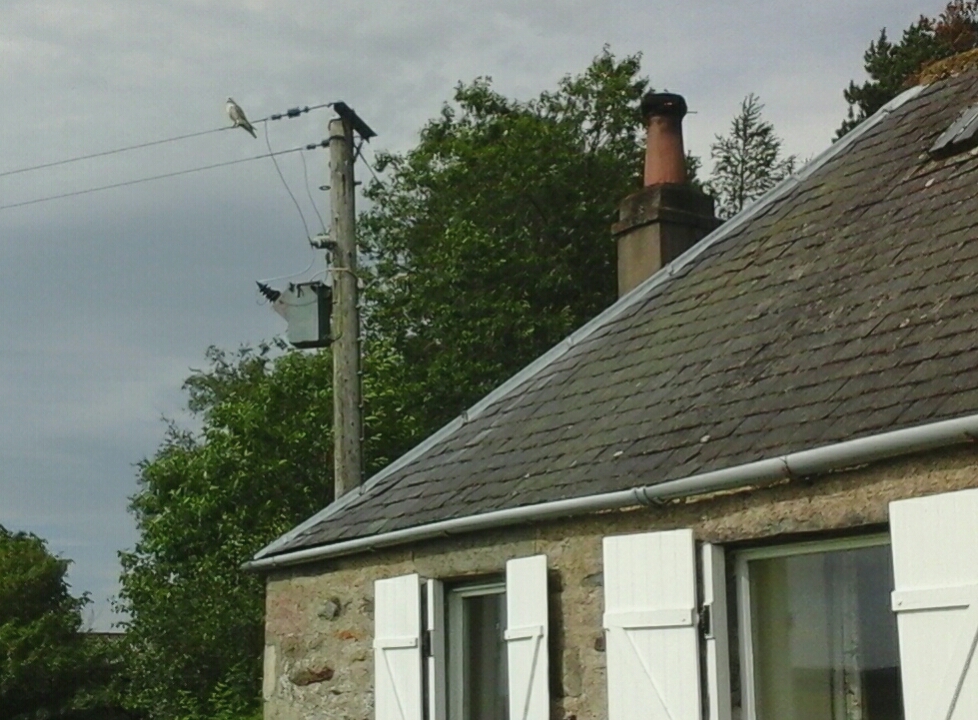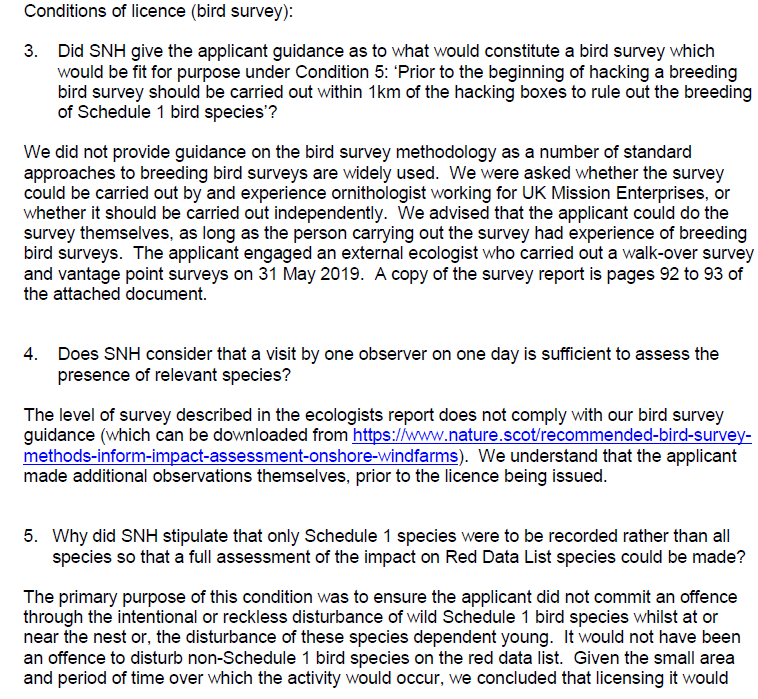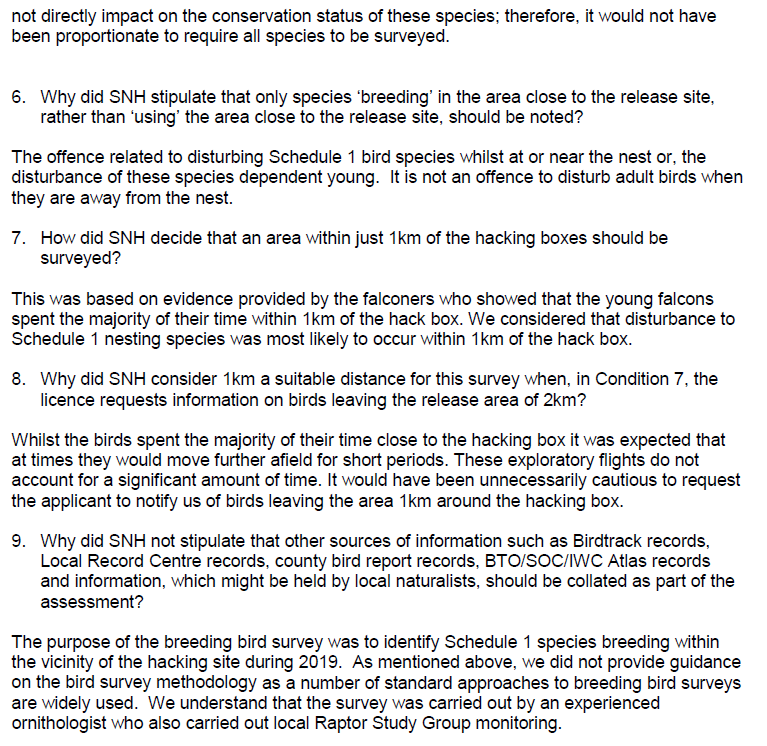
This post continues to explore the licensing of wild hacking of non-native falcons in the UK and uses information received from SNH about wild hacking licensed by them in Moray in 2019.
The licence to cover wild hacking of 150 Gyr Falcons was issued on 9 May and came into effect on 1 June. It required the licensee to carry out a bird survey and this was carried out by a consultancy on 31 May.
The survey was simply a wander around the hacking area and recording birds within 1km of that site. Only Schedule 1 species were recorded.



The survey was rather cursory, did not comply with published SNH guidelines, only included a very small area very close to the hacking site, was carried out on one day and only recorded Schedule 1 species which were actually breeding within 1km of the site. You couldn’t get a much more tightly constrained survey. If the area was used by a whole bunch of Schedule 1 species which nested some way away but not within 1km of the site then I don’t think they would have been mentioned. And if the area was full of cowering ground-nesting birds such as Black Grouse, Curlew and Lapwing they wouldn’t have been mentioned either. I’m presuming that the area is not a wader hotspot but the survey carried out would not have flagged this up. Perhaps more work to be done here in stipulating the quality of environmental impact assessment to be carried out?
I was amused to see that under community benefits the licensee stated that ‘As part of one of these agreements, a donation is given to GWCT for conservation work on upland waders.’. Made me smile anyway.
More on this tomorrow…
[registration_form]
The survey was carried out within 1 km of the hacking boxes. Some comments in earlier blogs were obviously from local residents. I wonder how close the residents live to the hacking boxes? Were their properties also part of the survey?
Paul S……. yes we live within 1km of the hacking box and no we were not surveyed. No local knowledge was even asked for after all our concerns.
Paul S We live within the magic kilometre radius of this establishment. In this and in previous years we have regularly witnessed the birds in question flying, resting and even ‘playing’, as I believe it’s called when they swoop on other birds or try to land on you.
Clearly, our disappearing curlew and oystercatchers aren’t important enough to be taken into consideration because, conveniently, they’re on a different, more challenging list.
And NO, were never approached as part of this ‘survey’.
Mark – the donation made me smile too. Why did SNH accept this report? None of our properties/land had the survey done……. all within 1km. Why was this report done the day before the licence was issued? Why was there no local knowledge asked for after all our concerns? It speculates there ‘might’ be a Hen Harrier or Merlin. Is that a survey? Black Grouse has been spotted over the years within the 1km area. We have waders galore….. does that constitute a ‘ hot spot’? If not why not? The second licence in Ayrshire was given in a Natura site, an SPA. Despite being deemed a risk by SNH. Shocking!
It beggars belief that the survey arrangements were left to the licence applicant. And then for SNH to just accept it, warts and all, tsk, tsk,tsk!
But, a survey was done so that box can be seen to be ticked.
Smoke and mirrors? Or window dressing at its finest.
It is actually quite disturbing that SNH focuses only on schedule 1 birds, as seems to be their general practise. One would hope that they would stick to their mandate:
https://www.nature.scot/about-snh/our-work/what-we-do
Looking how their own mission statement seems to be widely ignored by them when it comes to areas which are not SPA etc. – most of Scotland would fall into this category I would think – then I ask SNH this:
Is your long-term plan to confine our natural habitats and wildlife to national parks and nature reserves? Is our immediate local and rural environment not worth the bother?
If what one of the commenters above states is true, namely Scottish Natural Heritage granting a licence on one of their own Natura sites, what chance does anybody/any area in Scotland have in wanting to protect their natural habitat? Excuse me, what is Scottish, what is Natural, and what is Heritage about wild hacking a large number of non-native birds of prey? And who benefits?
This all sounds like a dereliction of duty on the part of SNH. A total disgrace and, it would appear, no sense of responsibility.
Were all the falcons accounted for at the end of the period? If yes, then “non native” has no bearing.
Whether native or non native, makes no difference unless a gyrfalcon evades capture. If it does evade capture, what are the chances of it ever breeding in the wild? None, cos gyrfalcons are non native.
What difference is there between a large number of falcons in one area, compared with a large number of other birds of prey concentrated “artificially” in another area?
Red Kites – kept unnaturally in an area for no other reason than someone making money at a feeding station.
You’ll say but Red Kites are supplementary fed at these stations, so that lessens any impact on ground nesting birds/chicks. Well the hacked Gyrfalcons are also fed while at hack.
So there is no difference as far as I can see.
If meetings are had concerning wild hacking, then surely meetings must also be had to discuss the effects of Red Kite feeding stations.
Rob – thanks for your first and nonsensical comment here.
The answer to your first question is in the previous blog about this subject – all of the falcons were accounted for. But the message you draw from this does not follow logically.
Your Red Kite analogy makes no sense at all.
Thank you again for your comment.
Mark, thanks for your reply. Please explain why it’s nonsensical.
Rob: What do you mean with your first two sentences? Don’t get the logic.
Falcons escape, gyr and others, see my comment yesterday. There may not have been escapees at the facility in question but they do escape.
I am no expert, but if gyrs and peregrines for instance, can be interbred in captivity I would assume that a gyr escapee can do the same with a wild peregrine?
Looking at the document Mark posted yesterday I see also gyr hybrids, peregrines and saker flown at the facility in 2018. According to a ornithologist friend of my brother, there are also quite some issues around peregrines. According to him, a lot of the peregrines bred and flown here in the UK are NOT native. They are imported from all over the place and there seem to be quite some reservation in the ornithology community about the introduction of ‘foreign’ peregrine genes.
Maybe an ornithologist is reading this and can comment?
Last but not least: How do we know that the facility is telling the truth? Is there a record somewhere to check how many birds they actually had to start with?
Hi Paul, the term “non native” why is that used?
I assume that there is a fear of non natives escaping and breeding with natives. If we were talking humans here, you could be called all kinds of non pc stuff.
Anyway, we’re talking falcons so, a non native gyr, escaping wouldn’t have any interaction with any native falcon.
The fact that gyr x peregrines are produced in captivity has no bearing on what happens in the wild.
I read earlier that they had 15 Peregrines last year. How many did they have this year? They are not mentioned. Did any go missing? Are they fitted with telemetry like the Gyrs? Did they venture outside 2km? As the days go on, there are more questions than answers.